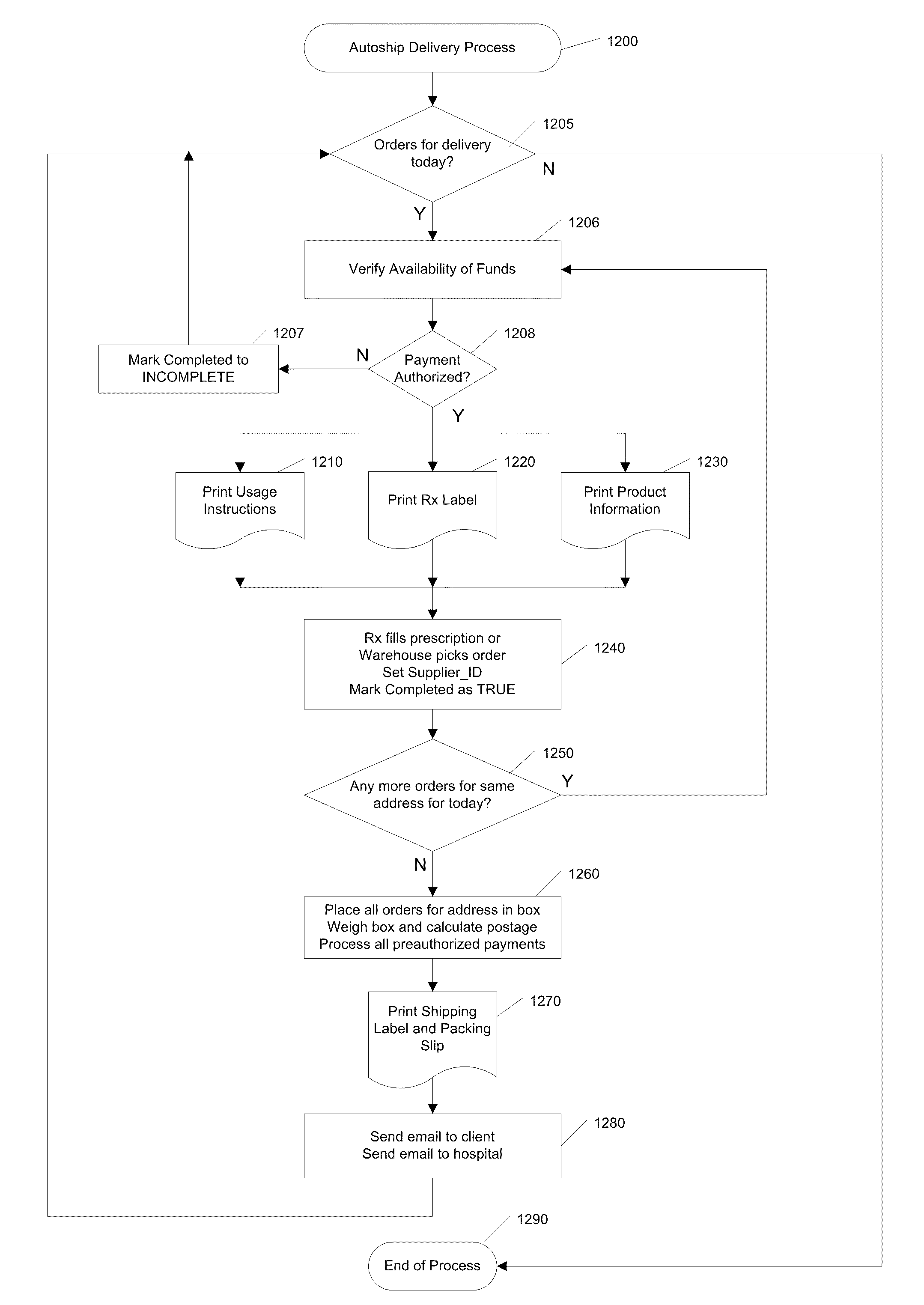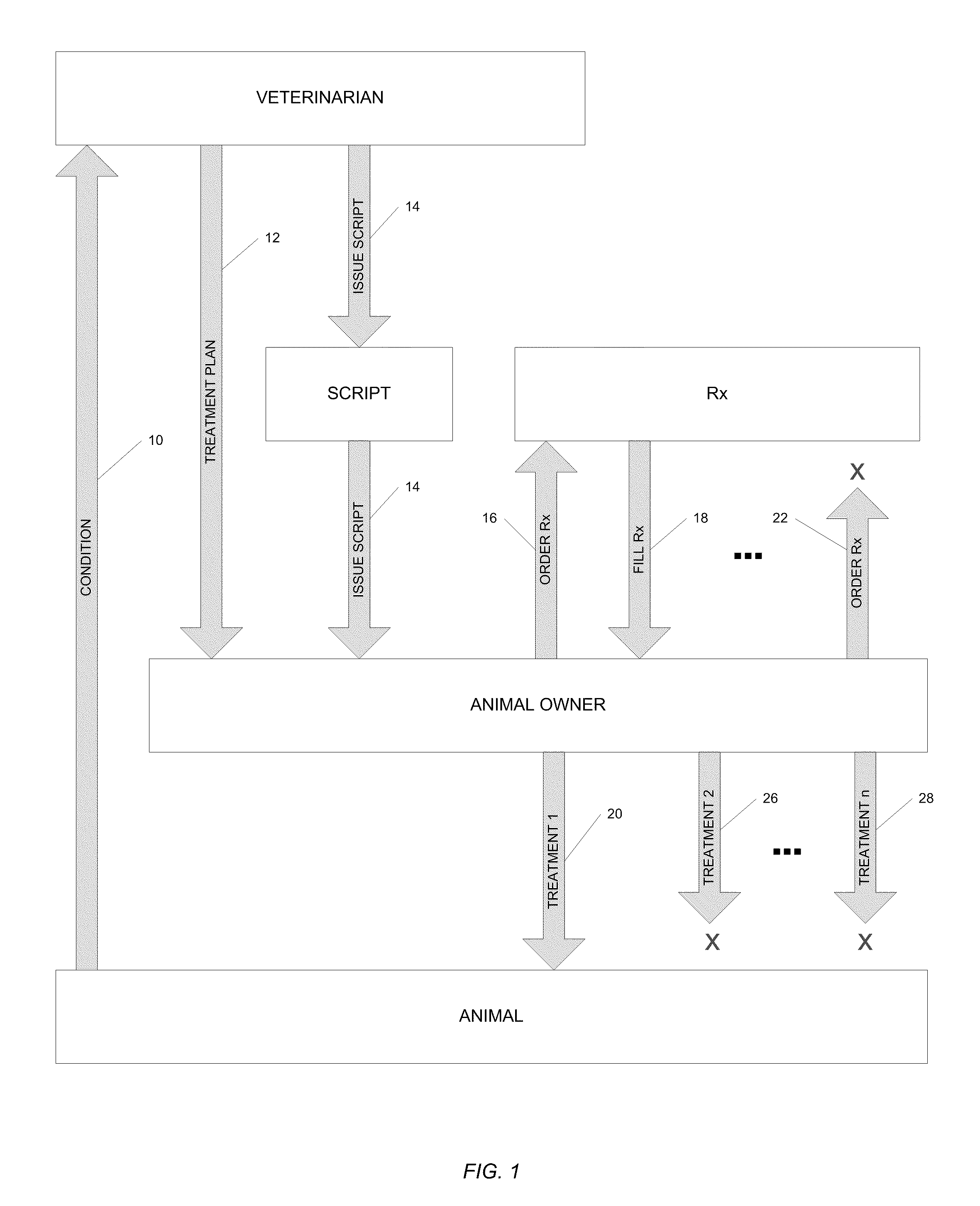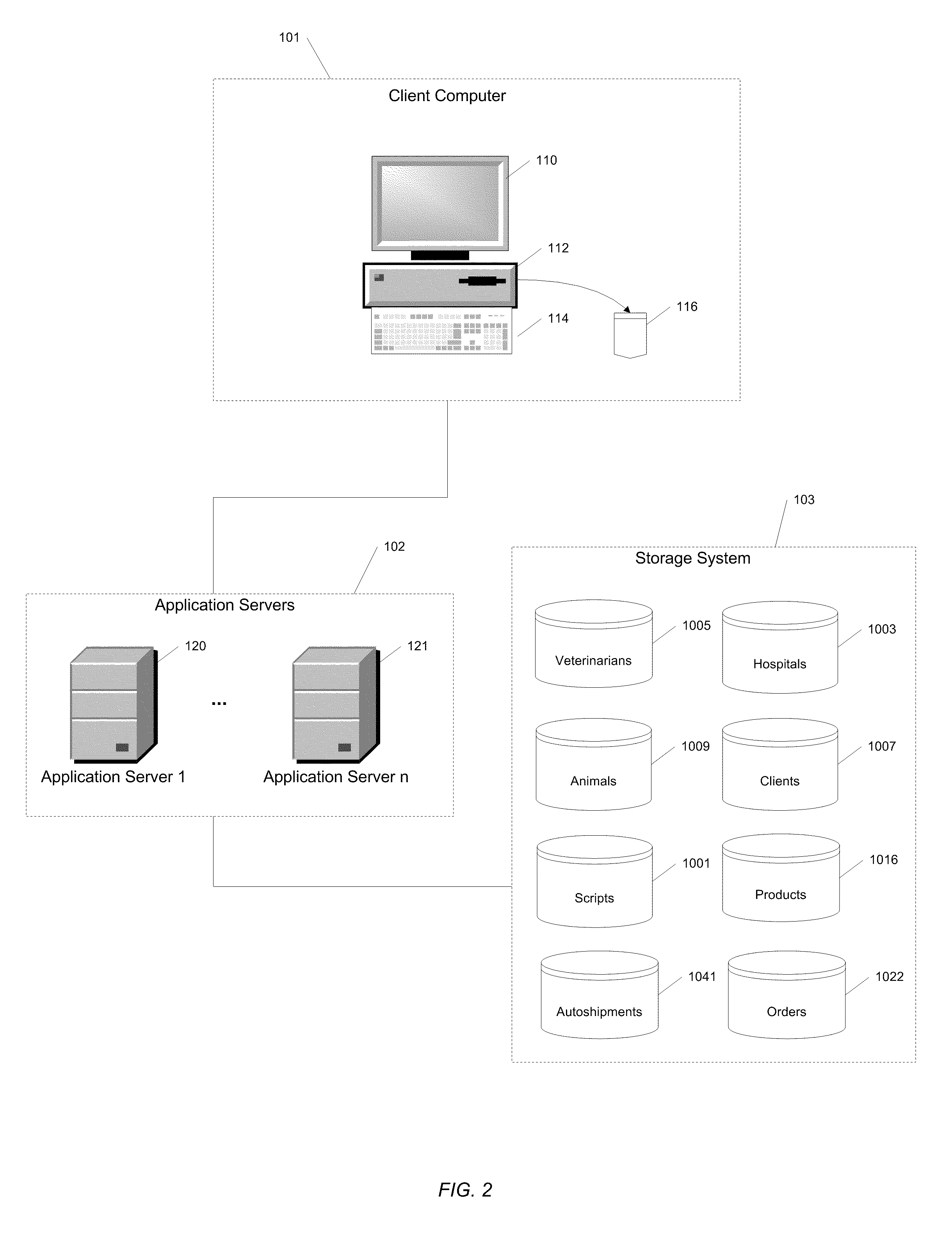However, this traditional method of treating animals with animal-related products has been subject to the primary shortfall of non-compliance of administering the recommended treatment to the animal as illustrated at 26, 28.
Largely, such noncompliance has resulted from inherent
delay and the inconvenience placed upon the owner to return to the veterinarian to renew prescriptions, to hand-carry prescriptions to the local
pharmacy, wait to have them filled, and to remember to administer the treatment as prescribed to the animal according to the treatment plan.
Since the animal has been mostly unable to indicate need for treatment, compliance has been left primarily to the owner in this traditional
scenario, and diminished compliance has resulted.
It is
distressing that there has been a very low compliance rate in the administration of pharmaceuticals to animals, documented as between 34-48 percent among customers of veterinary preventative medications, and 19% for therapeutic diets, as published in the 2003 AAHA study, The Path to High-Quality Care: Practical Tips for Improving Compliance.
Low compliance has also been due, in part, to the fact that there has not been implemented an effective delivery strategy for veterinary supplies to allow convenient and efficient application of the product to the animal.
Traditional prior art methods and systems of dispensing
veterinary pharmaceuticals have not employed effective means for veterinarians and their staff to positively
impact compliance of the animal owner in using the prescribed medication or supplement, leading to less
effective treatment outcomes.
Furthermore, prior non-computerized methods and systems of enabling, controlling and managing the
processing, fulfilling and dispensing of
veterinary pharmaceuticals and animal-related products have negatively impacted the ability of veterinarians and animal hospitals to effectively participate in the distribution of such products.
Thus, these prior systems and methods have negatively impacted the ability of veterinarians and veterinary hospitals of varying sizes, from smaller to larger hospitals, to effectively participate profitably in the sale directly to customers of the increasingly larger varieties of products available.
This has been in part due to the fact that it has been very difficult for the veterinarians and veterinary hospitals to maintain sufficient quantity of a sufficient number of different types of pharmaceuticals and supplements in inventory at the veterinarian's site, without these becoming outdated due to limited numbers of sales.
Furthermore, traditional manual pharmaceutical and supplement order, fulfillment and dispensing solutions, requiring separate trips by the animal owner to the
pharmacy, have not allowed the sale of the animal-related products in such a way as to provide a smooth and efficient transaction from the perspective of the veterinary hospital and the animal owner.
Nevertheless, these prior art solutions have lacked a coherent strategy and
computerized system for controlling and managing the script-writing, ordering, fulfillment and delivery of pet products in such a way as to enhance compliance with veterinary treatment plans and incentivize involvement in the ongoing treatment of the animal by the veterinarian and hospital.
Such systems have not been well designed to account for the fact that, in order for a veterinarian to issue a script, he or she must first see the animal for which the treatment plan is issued.
Therefore, while the telephone or Internet enabled model of distributing veterinary pharmaceuticals has facilitated the distribution of medicines, it still has lacked a viable method for the creation of effective animal treatment plans by a veterinarian that has seen the animal.
Of course, a veterinarian could call a remote
pharmacy and place a medication order, and that order could be shipped to the customer, but this method has required an additional step for the veterinarian to send the script to a remote pharmacy because there is no comprehensive
system for managing the process, including a comprehensive system for fostering an economic incentive for the veterinarian to call a particular pharmacy.
In fact, there may have been a disincentive for this relationship, because once the customer has been introduced to the pharmacy with this method, the pharmacy could have developed, and frequently has developed, a direct relationship with the animal owner, selling additional products and services with no economic benefit to the veterinarian.
While such practice may have been temporarily convenient and may have cost less in the short run for the pet owner, such practice has been considered by the American Veterinary Medical Association to not be appropriate, unless a prescription is issued in the context of a veterinarian-
client patient relationship.
All of these factors highlight the inherent
potential conflict of interest that exists between online veterinary pharmacies and veterinarian hospitals.
Further, such systems have done little to improve the compliance of administering pharmaceuticals and supplements in accordance with a veterinarian-prescribed treatment plan, since in such case treatment has still been left almost exclusively to the animal owner.
Accordingly, it has been very difficult, if not impossible, for a veterinarian, or a small veterinary hospital, to have maintained in stock sufficient quantities of each of the many and varied medications available, without such supplies becoming stale, losing
potency, or expiring.
Further, the management of such inventory, even if possible, would be very cumbersome, labor intensive, and loss of revenue due to the need to appropriately discard expired medication has been significant.
While the foregoing clearinghouse-type centralized pharmacy solutions have sought to address this dilemma faced by veterinarians, as described above, the solutions have entailed other problems, have not addressed compliance issues as described, and have not adequately involved the veterinarian in the process or transaction sufficient to ensure the high-quality treatment that owners expect for their pets and other animals.
Also, these prior art systems have not addressed the need for an effective means of controlling and managing the script writing process itself.
While it would be advantageous to allow non-veterinary-doctor associates, veterinary assistants, to make preliminary selections of medications or supplements for a particular treatment situation, for later approval by a veterinarian, this has proven difficult to accomplish in real time with manual script generation processes in a busy hospital situation, since a veterinarian would need to be in more than one place at one time to approve many different scripts before each customer leaves the premises.
In practice, what has happened in the past at busy pet hospitals, is that a veterinarian might spend the
morning portion of his or her shift reviewing charts and unsigned scripts, tediously calling to awareness the details of each individual chart before approving the script, and so forth, until each script has been signed, often after the customer and its animal have already left the hospital.
There has been lacking with prior art attempts a means of efficiently updating veterinarians and hospital staff with new product offerings and training in such a way as to make this information easily available to the veterinarian at the point of prescribing.
This, in turn, has made it more difficult for the veterinarians to keep up with advances in products and types in order to be able to pass the benefits of the new products on to their customers.
Further, as a result of the limitations of prior art veterinary pharmacy methods and systems that have not provided for an integrated, computerized script generating and
processing capability at the point of customer advice, consult and interaction with the veterinarian, the veterinarian has been less able to be present during instruction to the customer and ordering in order to resolve discrepancies.
This, in turn, has resulted in a more costly, less efficient system overall, and furthermore has resulted in a lack of access to and control by the hospital over the transaction.
This has been very costly to the veterinarian and hospital in the past, because they have not been able to effectively dispense the wider array of medicines and supplements available to the larger centralized pharmacies that dispense by mail directly to the customer.
Not only has this adversely impacted the ease of the veterinarian to provide care, but also has made it virtually impossible for the veterinarian to participate in the transaction financially.
One result of this lacking has been a lower rate of compliance in administering the
medicine to the pet, simply because the veterinarian has not been involved in the transaction and there have not been adequate reminders in place for the customer.
This is inefficient compared to an integrated system and leaves more to chance the hope that the veterinarian, or even less likely the staff member, will remember a particular
medicine alternative, of many such alternatives including possible generic options, at the point of presenting the option to the customer.
Yet another limitation of the prior art pet pharmaceutical and supplement supply system has been that veterinarians and staff have had limited animal and
medicine data readily available to work with to enable easier and more accurate creation and processing of a script.
This, in turn, makes it more difficult to efficiently prescribe the right dosage and type of medication based upon detailed
animal data accessible through a data repository.
With prior art methods and systems, the veterinarian has had to tediously call to attention all of the details of the
treated animal's history by manually reviewing the animal's hard-copy, printed file before prescribing a
treatment regimen.
 Login to View More
Login to View More  Login to View More
Login to View More 


